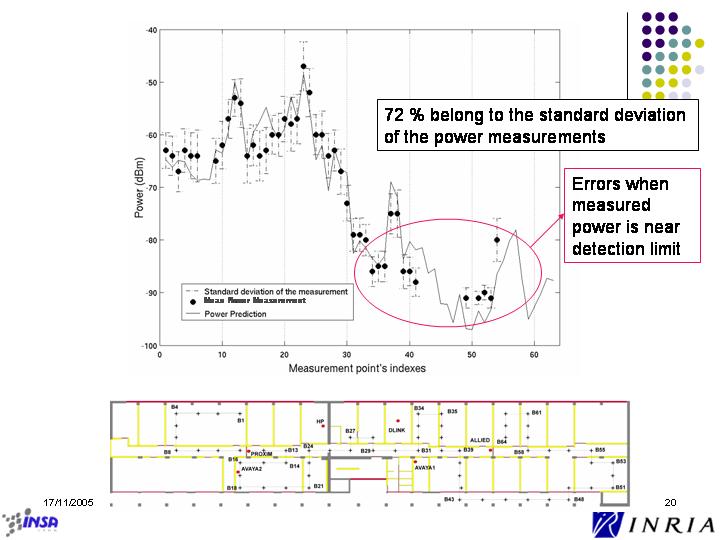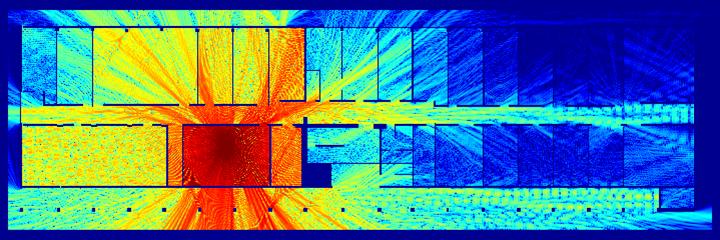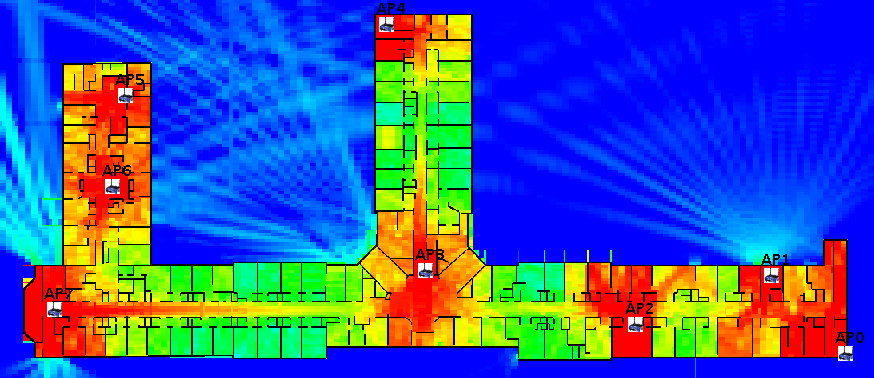My
research activities deal with RF signal processing and numerical simulation of wave
propagation. I worked until 2002 in the field of medical imaging for echocardiographic RF images.
Since
2000, I'm working in the field of wireless
networks simulation, modeling and optimization.
- Wireless networks are
growing very fastely since 2000, following the exceptional
development of cellular networks in the nineties. WiFi widely contributed to
this development firstly in professional environments but even now in private
areas. The use of WiFi in a wide variety of areas such as airports, museum,
hotels, universities, ..., has shown the failures of this technology: unstable
handovers, limited throughput, lack of independent channels, ...
The IEEE802.11 standard
evolved to fulfill more and more constraints improving its efficiency in larger
and more complex environments. Although first deployments were successfully
done empirically, actual deployments require now a better planning process to
overcome the limitations of this technology. Such a planning process requires
software tools based on two main components. The former is an Indoor
propagation simulator
and the later an access network optimizer. Both aspects are dealt with in our
work.
- The concept of ad-hoc
network may been seen firstly as a way to increase the coverage of standard
wLAN. Ad-hoc networks are now thought as adaptative ans autonomous networks.
Moreover, the sensor network field of applications allows to investigate
specific solutions for which the throughput is not the main constraint. Lot of
works devoted to ad-hoc network protocols are based on very simple radio
models. We are dealing with realistic physical layer modeling taking into account the radio
channel properties (propagation, fading, ...) on the one hand, and the radio
interface properties on the other hand. For this purpose, we have designed a radiocom
testbed allowing to
analyze existing systems and helpful for the design of new interfaces.
UHF
wave propagation in Indoor environments détails
|
fig 1: coverage map of an access
point in our lab |
Indoor UHF wave
propagation is a hard problem studied for 15 years. Two kinds of methods are
usually proposed. The former includes empirical approaches based on a
statistical modeling of the propagation behavior. They need a wide set of
measurments. The later includes methods so called determinsitic because they
exploit a physical model of the wave propagation. The most famous
deterministic approaches are based on the geometrical optic modeling leading
to ray-tracing based methods. These methods have been widely studied in the
field of Indoor propagation. In the opposite, discrete approaches such as
FDTD or TLM have been more rarely used for Indoor propagation simulations
because of their high computational load. |
We have developped a
new approach based on a TLM like formalism in the frequency domain, and
exploiting a multi-resolution decomposition of the environment. Such a
decomposition allows to reach very fast computational times when compared to
the original time-domain approach. Typically, a dense radio coverage of a N.N
pixels is solved in O(log2(N).N2), thus with a complexity
comparable to those of a standard multi-wall model (MWM) approach exploiting
only direct paths. It should be emphasized that in our approach all paths are
taken into account. Such a low computational complexity is reached taking
advantage of the mult-resolution tree computed during a pre-processing phase
having a complexity in O(N3).
Calibrated simulation
results have been compared to experimental measurements. they exhibit a mean
quadratic error of about 5dB only.

fig 2:
comparaison of simulations with measurements for a foot-path in the lab.
wireless LAN optimization détails
wireless LAN optimization
aims to select a subset of access points (AP) among a list of possible
candidates, in order to reach a given quality of service (QoS). This QoS can be
defined simply as a network access garanty needing only to verify the coverage area
of each selected AP. It can be often better to define this QoS by the use of
more applicative criteria such as maximizing the throughput per user, giving a
minimal throughput everywhere to allow VoIp applications or maximizing the
minimal number of APs seen everywhere for lacalization applications.
Interferences have to be dealt with to allow an efficient channel allocation
(FAP).
Our approach exploits the
multi-resolution structure of the WILDE engine, allowing to reach smart
computational times.
|
fig 3:the AP candidates are the
center of homogeneous nodes of a size larger than a given threshold. |
1- The candidate positions are firstly selected from the mutli-resolution tree obtained with the simulation engine, allowing to take automatically into account the environment geometry. The coverage is then computed for each AP. |
|
fig 4: Optimal AP selection for a
localization service. |
2- All coverage
combinations are tested with respect to the chosen criteria, and allowing to
compare the cost of each potential solution. Because a greedy algorithm is
not efficient enough, a Tabou heuristic is used to find an optimal solution. |
Radiocommunications
testbed détails
TODO
physical layer modeling of ad-hoc networks détails
TODO
Ultrasound
contrast agent (1998-1999,
Bracco Research, S.A.)
Basée sur les
propriétés de résonance des bulles d'air, la technique repose sur l'injection
de micro-bulles dans l'organe à explorer, via le système artériel. Ces
micro-bulles réagissent aux ultrasons comme des réflecteurs puissants et
peuvent être localisées grâce à l'imagerie ultrasonore conventionnelle.
Cependant, la pratique clinique n'en est encore qu'à ses débuts et de
nombreux points restent à explorer. Actuellement nous travaillons sur 2 aspects
de ces agents de contraste.
Le premier point sur lequel j'ai travaillé concerne la modélisation des agents
de contraste. Il s'agissait de prédire le comportement d'une population de
bulles sous l'action d'une onde ultrasonore. Plusieurs modèles mathématiques
ont été proposés, mais les choix dépendaient du type de produit, de la quantité
de bulles ou encore de la puissance de l'onde incidente. L'objectif était de
simuler fidèlement le comportement des agents de contraste développés à Bracco.
A plus long terme, il s'agissait de proposer un outil permettant l'aide à la
conception de nouveaux produits.
Le deuxième point concernait la mesure des propriétés acoustiques des agents de
contraste. Il s'agissait de mettre en place un banc de mesures fiable
conduisant à des résultats absolus, indépendants du système de mesure. Toutes
les mesures acoustiques étaient basées sur une analyse spectrale locale des
signaux rétrodiffusés par l'agent de contraste.
RF
signal processing for ultrasound imaging ( 1993-1998, CREATIS )
Les images échocardiographiques
conventionnelles (B-scan) correspondent à l'enveloppe des signaux de
radiofréquence (RF) fournis par la sonde ultrasonore. Les progrès
technologiques récents en matière d'acquisition de données permettent
l'obtention de l'ensemble des signaux RF formant l'image RF. Plusieurs études
expérimentales ont montré que l'analyse spectrale locale de ce type d'image
doit permettre de quantifier l'état pathologique de certains tissus comme le
muscle myocardique. Méthodologiquement, une telle analyse spectrale est
complexe du fait du caractère aléatoire et non stationnaire des signaux RF.
Dans ce cadre, nous avons développé une méthode originale basée sur une
estimation paramétrique autorégressive (AR) locale. En considérant les
paramètres AR comme des variables aléatoires, la modélisation Markovienne nous
a permis d'introduire une contrainte de lissage spatial, préservant les
discontinuités. Après avoir testé les méthodes de résolution stochastique, nous
avons adapté un algorithme déterministe (minimisation semi-quadratique), en
utilisant la structure récursive des coefficients de réflexion.
Pour permettre une validation expérimentale de ces données, nous avons
mis en place en 1996 une collaboration avec l'équipe du laboratoire
"Medical Image Computing" (LMIC) de l'Université de Leuven, Belgique,
qui a développé un système d'acquisition spécifique pour les séquences d'images
cardiaques RF. Pour mener à bien cette collaboration soutenue par le ministère
des affaires étrangères (programme d'actions intégrées "Tournesol"),
j'ai séjourné pendant 3 mois à Leuven. Les résultats obtenus sont très
encourageant et la méthode proposée devra être testée sur plusieurs cas, sains
et pathologiques.
.
3D cardiac motion
estimation
(1992-1997, CREATIS
)
Les travaux de recherche que j'ai effectués en partie
dans le cadre de mon DEA et concernant l'analyse du mouvement 3D étaient
intégrés dans les travaux du thème "Imagerie Dynamique". Grâce à des
données expérimentales acquises sur cœur de chien à l'aide du scanner X 3D de
la Mayo Clinic de Rochester, nous avons pu calculer et visualiser de façon
dynamique la distribution spatio-temporelle des vitesses de contraction et de
dilatation des parois du cœur gauche in-vivo. Pour ce faire, nous avons mis en
œuvre en 3D une méthode différentielle d'estimation de mouvement avec
contrainte de divergence nulle. Les résultats obtenus ont montré une très bonne
cohérence avec la physiologie connue du mouvement cardiaque.


